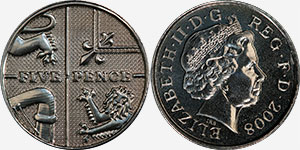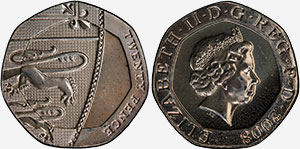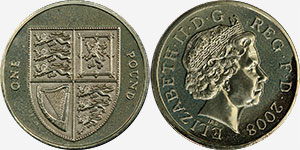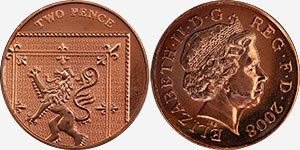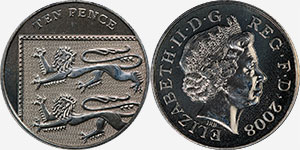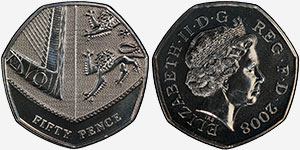The Royal Shield of Arms - 2008 to 2024 Coins Designs
By Coinsanduk | Tuesday, 24 December 2024
The coinage of the United Kingdom changed drastically in 2008. Familiar designs that have served for almost 40 years were replaced by a new set of designs, contemporary in treatment and in the traditions of the coinage. The series that has been chosen draws inspiration from the very fabric of British history.
The Royal Mint revealed the new designs saying that the coins focus on details of the shield of the Royal arms and when placed together they reveal the complete shield.
This is undoubtedly one of the most significant coin design changes in British history, and to mark this major numismatic milestone, the Royal Mint is offering an exciting range of limited-edition collections, giving collectors the opportunity to own a piece of numismatic history.
- Royal Mint
Specially invited artists, Royal Mint engravers and artists from other European countries vied with people of all ages and sections of society participated in the competition. The brief allowed those taking part a free hand to prepare a coherent series of designs and while they were encouraged to explore heraldic emblems and motifs, the door was left open for other ways in which to symbolise Britain.
The new designs were chosen via an open competition which was widely publicised in the national media in August 2005 and it attracted 4,000 entries. The winning designer was 26-year-old Matthew Dent, originally from Bangor and worked in London as a graphic designer.
After exploring a number of different options, Matthew Dent developed the heraldic theme, taking the heraldic device, the Royal Arms, which has been given a contemporary treatment and its whole has been cleverly split among all six denominations from the 1p to the 50p, with the £1 coin displaying the heraldic element in its entirety.
I felt that the solution to the Royal Mint's brief lay in a united design - united in terms of theme, execution and coverage over the surface of the coins. I wondered about a theme of birds or plants, but also considered buildings and coastal scenery. The issue with this for me lay in their distribution; how to represent the whole of the United Kingdom over six coins. The idea of a landscape appealed to me; perhaps using well-known landscapes from different areas around the United Kingdom which could stretch off the edge of one coin onto another. This seemed like a good solution but I also wanted to look at other options and themes.
I thought the six coins could make up a shield by arranging the coins both horizontally, as with the landscape idea, as well as vertically, in a sort of jigsaw style. I liked the idea and symbolism of using the Royal Arms, where individually the coins could focus on specific elements and when placed together they reveal the complete Royal Arms.
I found the idea that members of the public could interact with the coins the most exciting aspect of this concept. It's easy to imagine the coins pushed around a school classroom table or fumbled around with on a bar - being pieced together as a jigsaw and just having fun with them.
- Matthew Dent
Each and every one of the 4,000 designs was examined by the Royal Mint Advisory Committee before its preferred design was recommended to the Chancellor of the Exchequer in his capacity as Master of the Mint and finally approved by Her Majesty The Queen. Through a process of short listing and many revisions, a series by a designer previously unknown to the Royal Mint was ultimately selected and given royal approval.
This was the first time that a single design has been used across a range of United Kingdom coins.
As a powerful symbol of royal authority the Royal Arms, in its various forms, has featured on the coinage of almost every monarch since the reign of Edward III (1327-77). Coins were, and still are, issued under the personal authority of the monarch and came to be regarded as vehicles for royal imagery, whether in the form of a portrait or a monarch’s personal Coat of Arms.
Virtually unchanged since the reign of Queen Victoria, the Royal Arms is a symbol of the Queen’s authority over the whole of the United Kingdom, and has been used to powerful effect by numismatic artists over the course of her reign. The modern £1 coin of 1983 appropriately bore the Royal Arms on its reverse, the detailed depiction by Eric Sewell a famous symbol of British currency. This was followed in 1988 with a £1 reverse design by Derek Gorringe depicting a crowned shield of the Royal Arms, reminiscent of the early sovereigns of Queen Victoria.
The Royal Arms is divided into four parts: England being represented by the three lions passant guardant in the first and fourth quarters, the Scottish lion rampant in the second and the harp of Ireland in the third, with all four quarters spread over the six coins from the 1p to the 50p.
The designs entered circulation gradually throughout 2008.
To mark this release, the Royal Mint offered a range of limited-edition collections in proof and in base metal, platinum, silver and gold.


